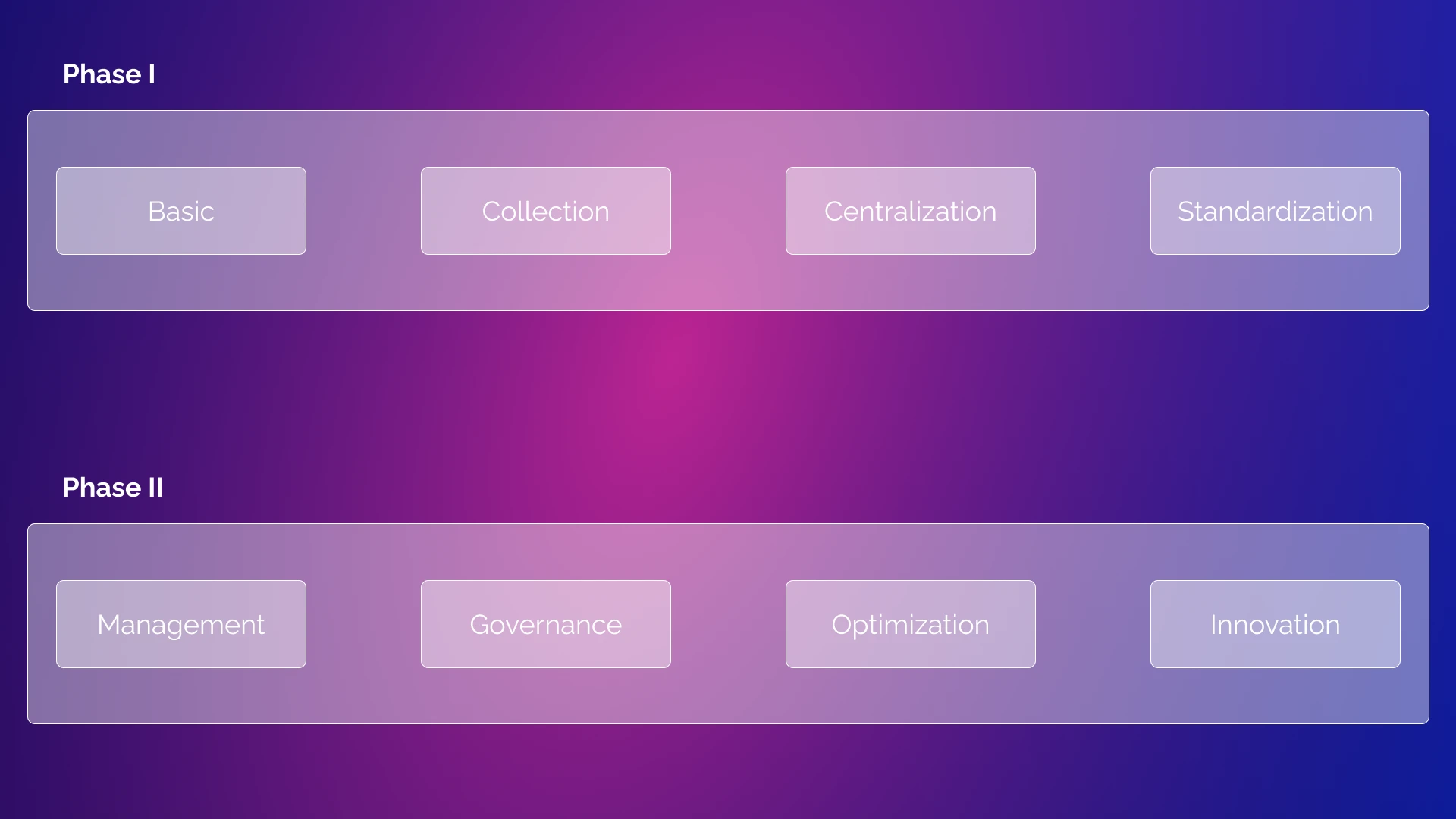
Orhan Gazi Yalçın
7 Min Read
Explore how Vizio’s SME Data Maturity Model helps e-commerce businesses achieve data-driven success with ease.
Introduction
Data Maturity Models are a framework that helps organizations assess their current level of data management capability and provides a roadmap for improving data practices. A data maturity model typically outlines progressive stages or levels of maturity, each representing a more advanced state of data management and utilization. Organizations can use this model to identify where they stand in terms of data maturity and what steps they need to take to advance to the next level.
Vizio AI's SME Data Maturity Model is designed to guide small and medium-sized enterprises (SMEs) on their journey to becoming data-mature. Unlike enterprise models that require extensive resources, Vizio's model is tailored for smaller organizations, offering practical, out-of-the-box solutions supported by the management team's efforts.
This blog post delves into Vizio AI's Data Maturity Model's two key phases and eight stages, providing actionable steps and highlighting the benefits at each stage.
Phase I: Building Blocks
The "Building Blocks" phase lays the groundwork for robust data management practices through four foundational stages: Basic, Collection, Centralization, and Standardization.
Stage 1: Basic
At the Basic stage, organizations often have minimal or no structured data management practices. MIS systems are underutilized, and data is stored inconsistently across multiple platforms. The primary focus at this stage is understanding the existing data landscape and taking the first steps toward data organization. Conducting thorough data audits and defining basic data management practices are essential. The goal here is to establish foundational data awareness and initiate structured data management practices. Though there are no immediate benefits in terms of data maturity, this stage sets the stage for more advanced practices.
Stage 2: Collection
In the Collection stage, organizations begin to standardize the use of MIS tools and establish basic data collection practices. The focus shifts to improving managerial awareness of data's value, though lower levels of the organization may not yet be engaged. Integrating MIS systems, establishing data collection standards, and starting isolated analytics projects in key business areas are crucial actions. Enhancing data collection capabilities by standardizing MIS tool usage across the organization can lead to improved operational efficiency, resource management, and project accountability.
Stage 3: Centralization
The Centralization stage focuses on consolidating data assets to reduce redundancy and enhance accessibility. Organizations evaluate current data architecture and develop a centralized data infrastructure. Implementing ETL processes to streamline data flows across the organization becomes vital. Achieving a centralized approach to data management helps in reducing redundancy and improving data accessibility. This stage also emphasizes developing robust data infrastructure, which supports efficient data flows and storage, setting a foundation for advanced data operations.
Stage 4: Standardization
Standardization refines data management practices, ensuring data is clean, well-organized, and efficiently stored. Organizations implement comprehensive data cleansing and normalization practices to enhance data accuracy. Standardizing data formats and protocols across the organization ensures consistency. This stage prepares SMEs for more sophisticated data analysis and management techniques by enhancing data quality and reducing storage costs. Standardized data processes reduce the effort needed to manage data, allowing staff to focus on more value-added activities.
Phase II: Strategic Leverage
The "Strategic Leverage" phase focuses on advanced data management practices through four stages: Management, Governance, Optimization, and Innovation.
Stage 5: Management
At the Management stage, the organization has achieved a high level of data centralization and standardization. The focus now shifts to efficiently managing this data to maximize its utility across all business functions. Developing and refining metadata management practices, establishing data lineage systems, and optimizing data storage solutions are key actions. This stage emphasizes turning data into actionable insights, improving data utilization, and increasing operational agility.
Stage 6: Governance
The Governance stage establishes frameworks and policies for managing data risks and ensuring compliance with legal and regulatory standards. Organizations develop data classification protocols and enhance data compliance measures. Strengthening data security frameworks and integrating responsible AI and IoT practices support secure, sustainable growth. This stage ensures that robust governance frameworks reduce the risk of data breaches and unauthorized access while maintaining compliance with evolving data protection regulations.
Stage 7: Optimization
Optimization refines and enhances data processes to maximize efficiency, accuracy, and utility. Organizations implement automation and machine learning to streamline data usage and drive innovation. Developing a distributed data lake and integrating machine learning algorithms to analyze historical data patterns are critical actions. This stage aims to create a highly efficient, predictive, and proactive data environment that supports agile decision-making and operational excellence.
Stage 8: Innovation
The Innovation stage represents the pinnacle of data maturity, where the organization uses data to drive groundbreaking innovations. Advanced technologies like deep learning enable the organization to become a real-time enterprise that is highly responsive and proactive in its operations. Leveraging data for strategic decisions, embedding advanced analytics into business processes, and using predictive analytics to anticipate market changes are essential actions. This stage fosters a culture of innovation, allowing the organization to continuously adapt and innovate, ensuring long-term success and relevance.
Implementation Principles
Vizio AI ensures that its Data Maturity Model is cost-effective and feasible for SMEs by adhering to principles such as streamlined implementation, utilization of affordable technologies, and a focus on core functionalities. The model promotes the use of cloud-based solutions and accessible training initiatives to enhance data management skills. It advocates for incremental change, emphasizing the tangible returns from progressing through the data maturity stages. By providing templates and frameworks and fostering a community for collaborative learning, Vizio AI ensures that SMEs can enhance their data capabilities cost-effectively.
Tool Stacks
Vizio AI tailors the toolkit to the specific needs of each client, selecting from platforms like Microsoft, AWS, Salesforce, Google Cloud, Segment, and Mixpanel. This customization ensures that SMEs receive the most effective combination of tools for their particular stage of data maturity, supporting sustainable success in their data-driven initiatives.
By following Vizio AI's SME Data Maturity Model, e-commerce businesses can progressively enhance their data capabilities, driving operational efficiency, innovation, and competitive advantage.






